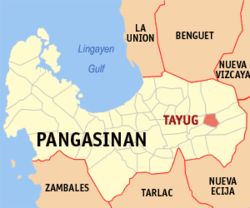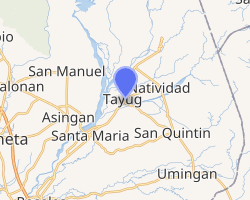Tayug, Pangasinan
Tayug, officially the Municipality of Tayug (Pangasinan: Baley na Tayug; Ilocano: Ili ti Tayug; Tagalog: Bayan ng Tayug), is a 3rd class municipality in the province of Pangasinan, Philippines. According to the 2015 census, it has a population of 43,149 people.[3]
Tayug | |
|---|---|
| Municipality of Tayug | |
Tayug Welcome Arch | |
 Seal | |
 Map of Pangasinan with Tayug highlighted | |
OpenStreetMap 
| |
.svg.png) Tayug Location within the Philippines | |
| Coordinates: 16°01′36″N 120°44′52″E | |
| Country | |
| Region | Ilocos Region (Region I) |
| Province | Pangasinan |
| District | 6th district |
| Founded | March 17, 1817 |
| Barangays | 21 (see Barangays) |
| Government | |
| • Type | Sangguniang Bayan |
| • Mayor | Carlos Trece R. Mapili |
| • Vice Mayor | Lorna P. Tacdol |
| • Congressman | Tyrone D. Agabas |
| • Electorate | 28,507 voters (2019) |
| Area | |
| • Total | 51.24 km2 (19.78 sq mi) |
| Population (2015 census)[3] | |
| • Total | 43,149 |
| • Density | 840/km2 (2,200/sq mi) |
| • Households | 9,837 |
| Economy | |
| • Income class | 3rd municipal income class |
| • Poverty incidence | 11.31% (2015)[4] |
| • Revenue (₱) | 114,844,832.61 (2016) |
| Time zone | UTC+8 (PST) |
| ZIP code | 2445 |
| PSGC | |
| IDD : area code | +63 (0)75 |
| Climate type | tropical monsoon climate |
| Native languages | Pangasinan Ilocano Tagalog |
The town of Tayug got its unique name not from people who were influential or from name of saints but from a very tall tree that once grew in the heart of the town; the bacayao tree was so tall that in Ilocano they call it “Layug”. In view of the difficulty of the people to pronounce the letter “L” they change it to letter “T” by common usage. Hence, the name Tayug came about.
Barangays
Tayug is politically subdivided into 21 barangays.
- Agno
- Amistad
- Barangobong
- Carriedo
- C. Lichauco
- Evangelista
- Guzon
- Lawak
- Legaspi
- Libertad
- Magallanes
- Panganiban
- Barangay Poblacion A
- Barangay Poblacion B
- Barangay Poblacion C
- Barangay Poblacion D
- Saleng
- Santo Domingo
- Toketec
- Trenchera
- Zamora
Climate
| Climate data for Tayug, Pangasinan | |||||||||||||
|---|---|---|---|---|---|---|---|---|---|---|---|---|---|
| Month | Jan | Feb | Mar | Apr | May | Jun | Jul | Aug | Sep | Oct | Nov | Dec | Year |
| Average high °C (°F) | 31 (88) |
31 (88) |
32 (90) |
34 (93) |
35 (95) |
34 (93) |
32 (90) |
32 (90) |
32 (90) |
32 (90) |
32 (90) |
31 (88) |
32 (90) |
| Average low °C (°F) | 22 (72) |
22 (72) |
22 (72) |
24 (75) |
24 (75) |
24 (75) |
24 (75) |
24 (75) |
24 (75) |
23 (73) |
23 (73) |
22 (72) |
23 (74) |
| Average precipitation mm (inches) | 13.6 (0.54) |
10.4 (0.41) |
18.2 (0.72) |
15.7 (0.62) |
178.4 (7.02) |
227.9 (8.97) |
368 (14.5) |
306.6 (12.07) |
310.6 (12.23) |
215.7 (8.49) |
70.3 (2.77) |
31.1 (1.22) |
1,766.5 (69.56) |
| Average rainy days | 3 | 2 | 2 | 4 | 14 | 16 | 23 | 21 | 24 | 15 | 10 | 6 | 140 |
| Source: World Weather Online[5] | |||||||||||||
Demographics
Tayug town hall and library
| Year | Pop. | ±% p.a. |
|---|---|---|
| 1903 | 10,400 | — |
| 1918 | 13,594 | +1.80% |
| 1939 | 16,222 | +0.85% |
| 1948 | 19,782 | +2.23% |
| 1960 | 20,755 | +0.40% |
| 1970 | 24,143 | +1.52% |
| 1975 | 26,153 | +1.62% |
| 1980 | 26,273 | +0.09% |
| 1990 | 31,575 | +1.86% |
| 1995 | 33,881 | +1.33% |
| 2000 | 36,199 | +1.43% |
| 2007 | 37,954 | +0.66% |
| 2010 | 40,018 | +1.95% |
| 2015 | 43,149 | +1.44% |
| Source: Philippine Statistics Authority[3][6][7][8] | ||
gollark: Then oh dear.
gollark: To scare it, I mean.
gollark: Hover fingers over the kill button?
gollark: Hmm...
gollark: Indeed.
References
- "Municipality". Quezon City, Philippines: Department of the Interior and Local Government. Retrieved 31 May 2013.
- "Province: Pangasinan". PSGC Interactive. Quezon City, Philippines: Philippine Statistics Authority. Retrieved 12 November 2016.
- Census of Population (2015). "Region I (Ilocos Region)". Total Population by Province, City, Municipality and Barangay. PSA. Retrieved 20 June 2016.
- "PSA releases the 2015 Municipal and City Level Poverty Estimates". Quezon City, Philippines. Retrieved 1 January 2020.
- "Tayug, Pangasinan: Average Temperatures and Rainfall". World Weather Online. Retrieved 31 October 2015.
- Census of Population and Housing (2010). "Region I (Ilocos Region)". Total Population by Province, City, Municipality and Barangay. NSO. Retrieved 29 June 2016.
- Censuses of Population (1903–2007). "Region I (Ilocos Region)". Table 1. Population Enumerated in Various Censuses by Province/Highly Urbanized City: 1903 to 2007. NSO.
- "Province of Pangasinan". Municipality Population Data. Local Water Utilities Administration Research Division. Retrieved 17 December 2016.
External links
| Wikimedia Commons has media related to Tayug, Pangasinan. |
This article is issued from Wikipedia. The text is licensed under Creative Commons - Attribution - Sharealike. Additional terms may apply for the media files.